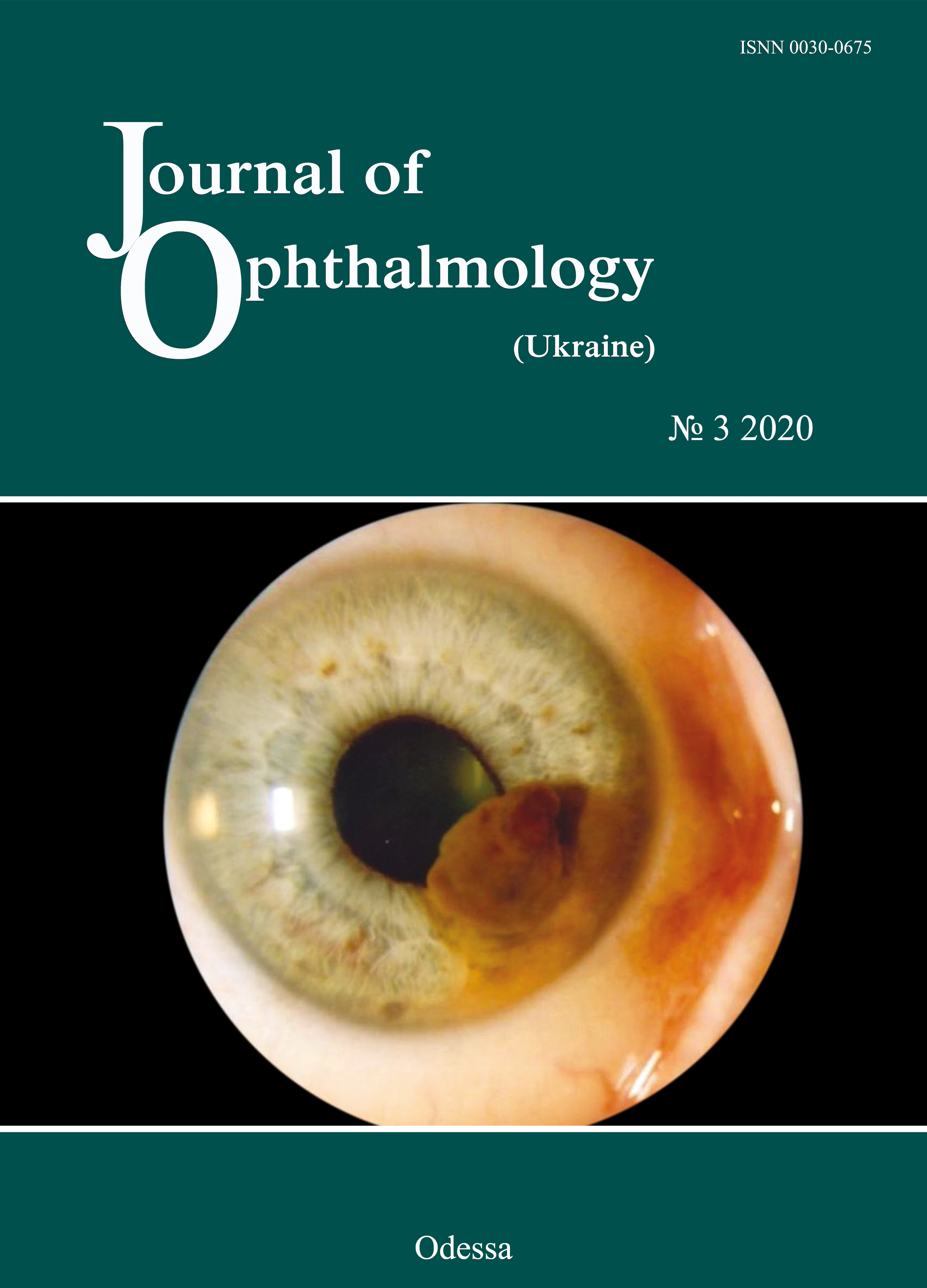Changes in temperature of the ocular surface in the projection of the ciliary body in the early stages of induced non-infectious uveitis in rabbits
DOI:
https://doi.org/10.31288/oftalmolzh202034752Keywords:
uveitis, objectively assess inflammation, ocular surface temperatureAbstract
Background: It is an important challenge to develop objective methods for assessing intraocular inflammation.
Purpose: To determine temperatures of the ocular surface in the projection of the ciliary body in rabbits with induced non-infectious anterior and intermediate uveitis in the first five days of the disease.
Material and Methods: Temperatures of the ocular surface in the projection of the ciliary body were determined in seventeen Chinchilla rabbits with induced non-infectious anterior and intermediate uveitis.
Results: At day 1, there was significant difference in temperature of the ocular surface in the projection of the ciliary body between challenged eyes and eyes of intact rabbits (р=0.002) and between fellow eyes and eyes of intact rabbits (р=0.005), but not (р=0.12) between the challenged eye and the fellow eye (35.7°С (1.1) vs 35.0°С (0.9)). At day 3, temperature for the challenged eye was 36.0°С (0.7), and for the fellow eye, 34.9°С (0.5), and the difference was not significant (р = 0.09), but there was significant difference between challenged eyes and eyes of intact rabbits. At day 5, a significant difference in temperature of the ocular surface appeared between the challenged eye and the fellow eye (36.0°С (0.7) vs 34.7°С (0.5); р=0.04), and there was still a significant difference between challenged eyes and eyes of intact rabbits (р=0.008). There was no significant difference in body temperature between challenged animals at day 1 and intact animals (39.1°С vs 39.1°С; р=0.75) and between challenged animals at day 3 and intact animals (39.2°С vs 39.1°С; р=0.58).
Conclusion: On day 1 of induced non-infectious anterior and intermediate uveitis in rabbits, the temperature in ciliary body projection onto the ocular surface increased to 35.7°С (р = 0.002) for the challenged eyes and to 35.0°С (р=0.05) for the fellow eyes compared to eyes of intact rabbits, which is likely to be caused by the response of the autonomic nervous system in the presence of initiation of inflammatory process. On day 5, a significant difference appeared in the ocular surface temperature between the challenged eyes and fellow eyes (36.0°С vs 34.7°С; р = 0.04), which is likely to be caused by decreased temperature response of the autonomic nervous system as well as by a gradual decrease in temperature of the fellow eye.
References
1.Acharya NR, Tham VM, Esterberg E, et al. Incidence and prevalence of uveitis: results from the Pacific Ocular Inflammation Study. JAMA Ophthalmol. 2013 Nov;131(11):1405-12.https://doi.org/10.1001/jamaophthalmol.2013.4237
2.Bodaghi B, Cassoux N, Wechsler B, et al. Chronic severe uveitis: etiology and visual outcome in 927 patients from a single center. Medicine (Baltimore). 2001 Jul;80(4):263-70.https://doi.org/10.1097/00005792-200107000-00005
3.Nussenblatt RB. The natural history of uveitis. Int Ophthalmol. 1990. 14:303-8.https://doi.org/10.1007/BF00163549
4.Suttorp-Schulten MS, Rothova A. The possible impact of uveitis in blindness: a literature survey. Br J Ophthalmol. 1996 Sep; 80(9): 844-8.https://doi.org/10.1136/bjo.80.9.844
5.Barisani-Asenbauer T, Maca SM, Mejdoubi L, Emminger W, Machold K, Auer H. Uveitis- a rare disease often associated with systemic diseases and infections- a systematic review of 2619 patients. Orphanet J Rare Dis. 2012 Aug 29;7:57.https://doi.org/10.1186/1750-1172-7-57
6.Bakbardina LM. [Thermometric diagnostics of inflammatory process in the anterior uvea]. [Abstract of a Thesis for the Degree of Cand Sc (Med)]. Odesa: Filatov Institute of Eye Disease and Tissue Therapy; 1988. Russian.
7.Astakhov IuS, Kuztetsova TI. [Laser flare photometry in clinical practice]. Oftalmologicheskie vedomosti. 2016;9(2):36-44. Russian.https://doi.org/10.17816/OV9236-44
8.Guney E, Tugal-Tutkun I. Symptoms and Signs of Anterior Uveitis. US Ophthalmic Rev. 2013;6(1):33-7.https://doi.org/10.17925/USOR.2013.06.01.33
9.Herbort CP, Guex-Crosier Y, de Ancos E, et al. Use of laser flare photometry to assess and monitor inflammation in uveitis. Ophthalmology. 1997 Jan;104(1):64-71.https://doi.org/10.1016/S0161-6420(97)30359-5
10.Ladas JG, Wheeler NC, Morhun PJ, et al. Laser flare-cell photometry: methodology and clinical applications. Surv Ophthalmol. 2005 Jan-Feb;50(1):27-47.https://doi.org/10.1016/j.survophthal.2004.10.004
11.Tugal-Tutkun I, Herbort CP. Laser flare photometry: a noninvasive, objective, and quantitative method to measure intraocular inflammation. Int Ophthalmol. 2010;30:453-64.https://doi.org/10.1007/s10792-009-9310-2
12.Wakefield D, Herbort CP, Tugal-Tutkun I, Zierhut M. Controversies in ocular inflammation and immunology laser flare photometry. Ocul Immunol Inflamm. 2010 Oct;18(5):334-40.https://doi.org/10.3109/09273948.2010.512994
13.Gonzales CA, Ladas JG, Davis JL, Feuer WJ, Holland GN. Relationships Between Laser Flare Photometry Values and Complications of Uveitis. Arch Ophthalmol. 2001 Dec;119(12):1763-9.https://doi.org/10.1001/archopht.119.12.1763
14.Yeo TH, Ilangovan S, Keane PA, et al. Discrepancies in assessing anterior chamber activity among uveitis specialists. Jpn J Ophthalmol. 2016 May;60(3):206-11.https://doi.org/10.1007/s10384-016-0438-0
15.Chernookova VA. [Clinical and functional patterns of oculo-ocular reflexes in unilateral mechanical ocular trauma]. [Abstract of a Thesis for the Degree of Cand Sc (Med)]. Moscow: Moscow Helmholtz Research Institute for Eye Diseases; 2007. Russian.
16.Dorokhova OE, Zborovska OV, Meng Guanjun. Temperature of the ocular surface in the projection of the ciliary body in rabbits. J. Ophthalmol. (Ukraine). 2020; 2(493):65-9.https://doi.org/10.31288/oftalmolzh202026569
17.Penkov MA, Saitov MA, Panchenko NV. [Certificate of authorship No. 1,601,629 (USSR). Method for inducing experimental toxic-and-allergic uveitis]. Issued 23.10.90, Bull. No. 39.
18.Anatychuck LI, Pasyechnikova NV, Zadorozhnyy OS, et al. Original device and approaches to the study of temperature distribution in various eye segments (experimental study). J. Ophthalmol. (Ukraine). 2015;6:50-3.https://doi.org/10.31288/oftalmolzh201565053
19.Aksionovа SV, Pyatayev NA, Malkina MV, et al. [Comparative examination of two methods for modeling autoimmune uveitis]. Mordovia University Bulletin. 2017; 27(3):428-39. Russian.https://doi.org/10.15507/0236-2910.027.201703.428-439
20.McDougal DH, Gamlin PD. Autonomic control of the eye. Compr Physiol. 2015 Jan;5(1):439-73.https://doi.org/10.1002/j.2040-4603.2015.tb00603.x
21.Sullivan DA, Stern ME, Tsubota K, Dartt DA, Sullivan RM, Bromberg BB (Eds). Lacrimal Gland, Tear Film, and Dry Eye Syndromes 3: Basic Science and Clinical Relevance Part B. Adv Exp Med Biol. Vol. 506. Springer; US, 2002.https://doi.org/10.1007/978-1-4615-0717-8
22.Stewart M, Webster JR, Stafford KJ, et al. Technical note: Effects of an epinephrine infusion on eye temperature and heart rate variability in bull calves. J Dairy Sci. 2010 Nov;93(11):5252-7.https://doi.org/10.3168/jds.2010-3448
23.Coles WH, Pandya RK, Anbar M, et al. Ocular surface temperature (ocular thermography) as a predictor of corneal wound healing. Invest Ophthalmol Vis Sci. 1988;29:313.
24.Fatt I, Forester JF. Errors in eye tissue temperature measurements when using a metallic probe. Exp Eye Res. 1972 Nov;14(3):270-6. doi: 10.1016/0014-4835(72)90013-9.https://doi.org/10.1016/0014-4835(72)90013-9
25.Freeman RD, Fatt I. Environmental influences on ocular temperature. Invest Ophthalmol. 1973 Aug;12(8):596-602.
26.Lorget F, Parenteau A, Carrier M, et al. Characterization of the pH and temperature in the rabbit, pig, and monkey eye: key parameters for the development of long-acting delivery ocular strategies. Mol Pharm. 2016 Sep 6;13(9):2891-6.https://doi.org/10.1021/acs.molpharmaceut.5b00731
27.Rosenbluth RF, Fatt I. Temperature measurements in the eye. Exp Eye Res. 1977 Oct;25(4):325-41.https://doi.org/10.1016/0014-4835(77)90100-2
28.Schwartz B. Environmental temperature and the ocular temperature gradient. Arch Ophthalmol. 1965 Aug;74:237-43.https://doi.org/10.1001/archopht.1965.00970040239022
29.Antonchik SL. [Temperature characteristics of the eye in health and some pathological processes]. [Abstract of a Thesis for the Degree of Cand Sc (Biol)]. Tyumen: State Medical Academy; 2005. Russian.
30.Katargina LA. [Endogenous uveitis in infants: Clinical, functional and immunological features and management of complications]. [Abstract of a Dissertation for the Degree of Dr Sc (Med)]. Moscow: Helmholtz Research Institute of Eye Diseases; 1992.
31.Khvatova AV, Katargina LA, Lokhmanov VP, Zibarov IN. [Use of distant thermography in uveitis in children]. Vestn Oftalmol. Sep-Oct 1991;107(5):46-9.
32.Mapstone R. Corneal thermal patterns in anterior uveitis. Br J Ophthalmol. 1968 Dec;52(12):917-21.https://doi.org/10.1136/bjo.52.12.917
33.Safronenkova IA. [Diagnostic value of orbital skin thermography in unilateral endogenous uveitis]. [Abstract of a Thesis for the Degree of Cand Sc (Med)]. Odesa: Filatov Institute of Eye Disease and Tissue Therapy; 1989. Russian.
34.Zadorozhnyy O.S., Savin NV, Buiko AS. Improving the technique for controlled cryogenic destruction of conjunctival tumors located in the projection of the ciliary body onto the sclera: A preliminary report. J Ophthalmol (Ukraine). 2018; 5:60-65.https://doi.org/10.31288/oftalmolzh201856065
35.Gokul KC, Gurung DB, Adhikary PR. Тhermal effects of eyelid in human eye temperature model. J Appl Math Informatics. 2014; 32 (5-6): 649-63.https://doi.org/10.14317/jami.2014.649
36.Rushton JO, Tichy A, Nell B. Introduction of the use of thermography and thermometry in the diagnosis of uveitis in horses: a pilot project. Vet Rec Open. 2015 Jun 27;2(1):e000089.https://doi.org/10.1136/vetreco-2014-000089
Downloads
Published
How to Cite
Issue
Section
License
Copyright (c) 2025 О. Е. Дорохова, А. В. Зборовська, Мен Гуаньцзюнь

This work is licensed under a Creative Commons Attribution 4.0 International License.
This work is licensed under a Creative Commons Attribution 4.0 International (CC BY 4.0) that allows users to read, download, copy, distribute, print, search, or link to the full texts of the articles, or use them for any other lawful purpose, without asking prior permission from the publisher or the author as long as they cite the source.
COPYRIGHT NOTICE
Authors who publish in this journal agree to the following terms:
- Authors hold copyright immediately after publication of their works and retain publishing rights without any restrictions.
- The copyright commencement date complies the publication date of the issue, where the article is included in.
DEPOSIT POLICY
- Authors are permitted and encouraged to post their work online (e.g., in institutional repositories or on their website) during the editorial process, as it can lead to productive exchanges, as well as earlier and greater citation of published work.
- Authors are able to enter into separate, additional contractual arrangements for the non-exclusive distribution of the journal's published version of the work with an acknowledgement of its initial publication in this journal.
- Post-print (post-refereeing manuscript version) and publisher's PDF-version self-archiving is allowed.
- Archiving the pre-print (pre-refereeing manuscript version) not allowed.












